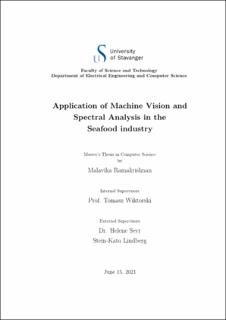| dc.description.abstract | The Norwegian seafood industry contributes largely to the global economy as Norway is one of the leading producers of seafood. Atlantic salmon is a widely consumed species of fish and has a large global market. The nutritional value of salmon is affected by its quality and the demand to evaluate it is a problem whose solution is a work in progress. Earlier, seafood quality evaluation used to be laborious, time consuming, and was done using invasive procedures. This has changed in the recent past and hyperspectral imaging has become a popular non-invasive procedure for quality evaluation.
Among the many factors contributing to the the quality determination of fish, the presence of blood after filleting is in some markets highly undesirable. Hyperspectral image analysis on cod fish has proven to be highly successful for blood detection, but application of the same technique on salmon is a more difficult problem as it contains pigments whose spectral properties are similar to that of blood and interferes in the blood analysis.
This study focuses on a novel approach to detecting blood in salmon fillets using hyperspectral image analysis. A comparative study was performed on two types of data, spectral and abundance data, extracted from the hyperspectral images of salmon fillets to predict the concentration of blood in each pixel using different machine learning models. A regression analysis using each model on both types of data was conducted to find the appropriate data and the model that produced relatively better results.
Out of the 3 linear models, 2 non-parametric models, 2 ensemble models and 1 neural model applied on both types of data for the regression analysis, the gradient boosting model performed best on the raw spectral data while the linear regression performed the best on the abundance data. The raw spectral data was found to be better than the abundance data when the gradient boosting was applied on it to predict the blood concentration when considering the evaluation metrics. A modified version of this model was then integrated into the Maritech eye product, which is a hyperspectral imaging setup to enable automatic quality evaluation of salmon fillets. | |
